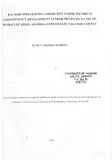| dc.description.abstract | Constituency Development Fund (CDF) was established under the CDF Act, 2003. It's an initiative of the Kenyan government to devolve 2.5 % of all government revenue to the 210 Constituencies to be administered at the Constituency level. The vision for the CDF is to devolve funds for equitable development and poverty reduction at the community level. Nine years into the program the fund has generated a lot of debate. There are many concerns raised on the local community participation in the CDF funded projects.
The purpose and objective of the study is to investigate the factors influencing community participation in the CDF projects in Kenya taking the case of Riabai location in Kiambaa Constituency. A sample of375 respondents was calculated as a good representative of the population. Stratified random sampling was used to draw the sample. Riabai location is made up of 2 sub locations which were treated as strata. The sub locations are further subdivided into villages. Riabai and Kihingo sub locations are made up of six and five villages respectively.
The respondents were identified through the sketch maps of the villages which were matched against a grid to identify randomly 35 respondents within the villages in Riabai sublocation and 33 respondents within villages in Kihingo Sub-location based on the population of each of the stratum. The questionnaires were sent to the respondents who filled and returned them for analysis. Data was collected, tabulated and edited. Close ended questions were coded to enable all the responses be keyed into the computer. Data collected was analyzed using SPSS.
Descriptive statistical procedures were used to describe the distribution and to derive patterns from the data. Summary statistics was used to calculate the mean, mode and percentages. Inferential statistics was used to carry out the chi square and t-test, Correlation analysis was done to analyze the different factors and their effect. The study found out that level of education, political considerations, publicity/community sensitization, distance, and government policy greatly influenced community participation while gender did not significantly influence community participation.
The study concludes that the government and development agencies should work closely with the local communities and all leaders to ensure that the local communities are encouraged to participate in projects. The government and development agencies should also look clearly at the factors influencing community participation to ensure that when designing policies they encourage and facilitate community participation. The findings of the study will assist the government and other development agencies when designing policies to ensure they encourage and facilitate community participation. | en_US |

